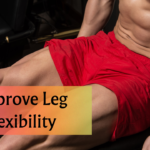The human organism is designed for motion. Therefore, active participation in physical activities is advantageous for maintaining good mental and physical health at any age. However, muscles and bones can experience deterioration with age due to wear and strain. However, there is a secret: initiating or maintaining any form of physical activity, including chair yoga, is crucial for preventing the onset of age-related weakness. Simply put, continue to move and continue driving!
Physical activity is highly beneficial for older people. According to the WHO, regular exercise reduces the risk of hypertension, diabetes, and cardiovascular disease in the elderly. Additionally, they possess enhanced cognitive abilities, improved cardiorespiratory fitness, reduced tension levels, elevated morale, and a healthier body mass.
Why Mobility Routines for Seniors in At-Home Care?
Getting in shape benefits one’s health, but what are the advantages?
As a consequence of aging, ligaments lose their flexibility. If an individual fails to continue moving, pain and stiffness may develop. Age-related decline can also affect the heart and arteries. These effects are reversible when the heart rate is increased through moderate exercise.
Due to the natural decline in metabolism that occurs with advancing age, weight gain may become problematic. Extra weight causes cardiovascular and pulmonary strain. Additionally, obesity is linked to additional health hazards.
Creating A Mobility Routine
1. Regular Schedule: Strive to integrate mobility exercises into your daily regimen, even if it only lasts ten to fifteen minutes daily.
2. Gradual Progression: Incorporating various exercises into the regimen will help maintain interest and target different aspects of mobility.
3. Gradual Progression: As flexibility and strength increase, begin with fundamental movements and progressively increase in complexity and duration.
4. Group Classes or Personal Training: Obtaining guidance and motivation can be achieved through participation in group classes or receiving personal training.
8 Mobility Exercises For Seniors
Eight Mobility Exercises for Seniors are as follows:
1. Shoulder Rolls
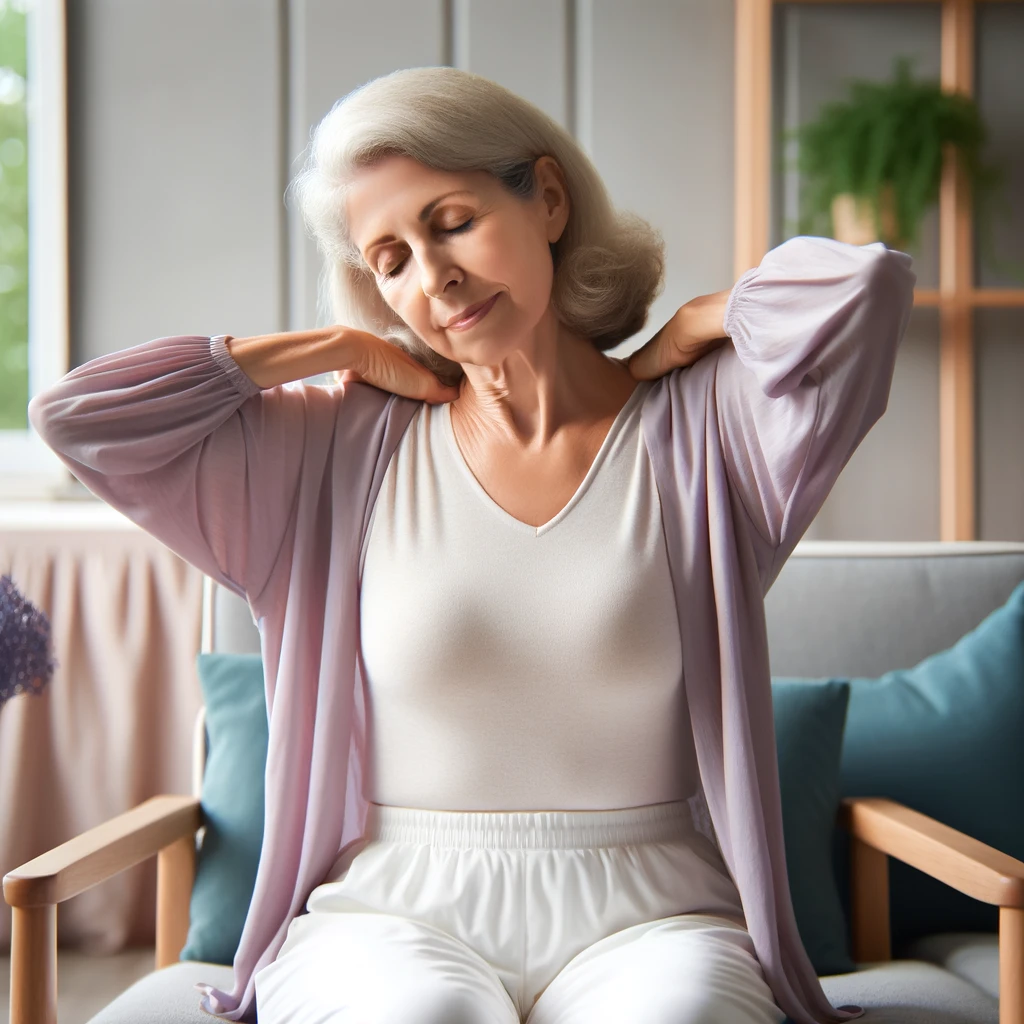
Shoulder rolls are straightforward exercises that stretch the shoulder muscles and ligaments. Sports like swimming and tennis and fundamental activities like reaching aloft require excellent shoulder mobility.
The way to execute a shoulder roll:
- Stand with your ankles separated by hip width.
- Raise your shoulders in the direction of your ears. Then, roll them forward in a gradual motion.
- Following approximately thirty seconds, rotate your shoulders backward.
- The following muscle groups are targeted: The Shoulders.
2. Arm Circles

This exercise engages the shoulders, biceps, and triceps while loosening the shoulder joints. It is a simple method to prepare your arms and shoulders for activities such as swimming and pickleball while also improving your posture.
To execute an arm circle:
- With your feet shoulder-width apart, assume an erect stance.
- Extend and elevate the arms in a lateral position.
- Rotate your arms forward in small circles for thirty seconds while maintaining an erect elbow position. Then, rotate your arms backward in small circles for thirty seconds.
- Targeted Muscle Groups: Shoulders, Biceps, Triceps, and Upper Back
3. Hip Circles
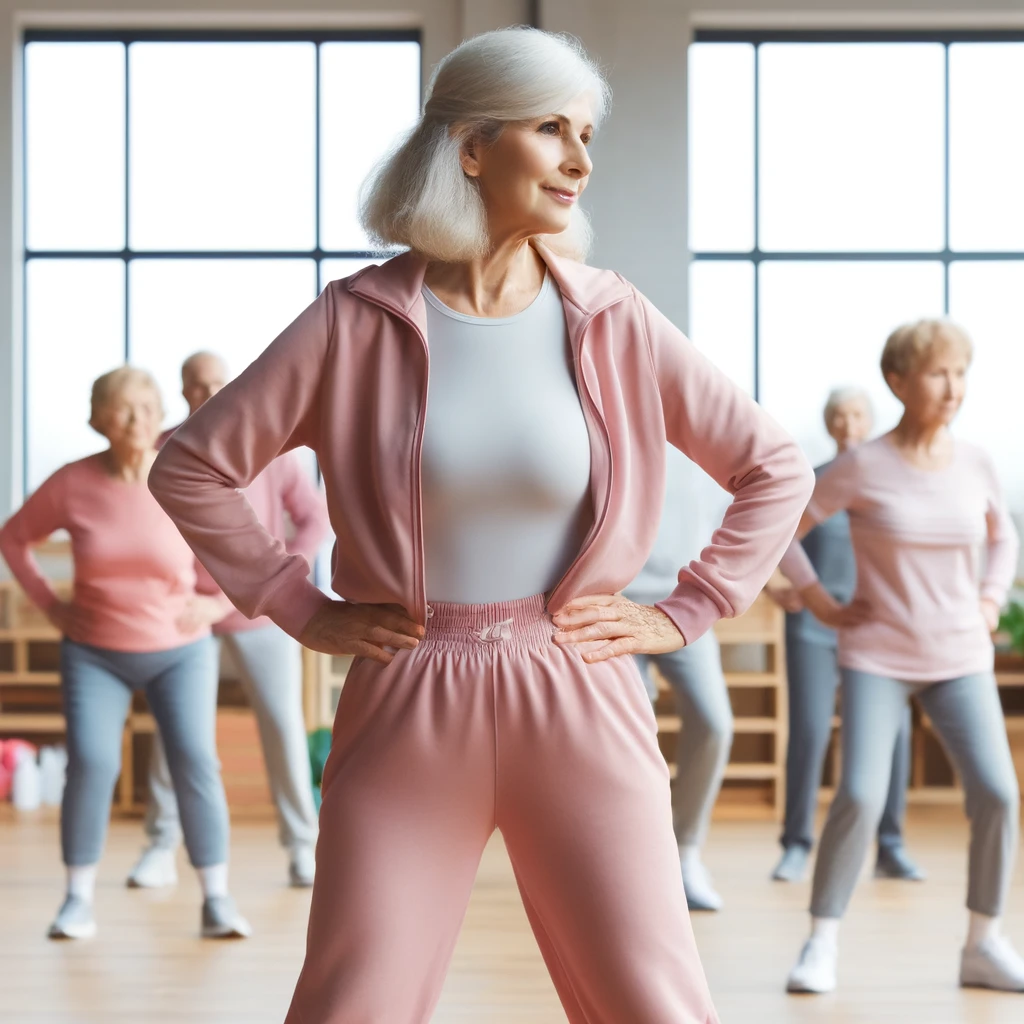
This straightforward exercise aids in the relaxation of the hip muscles and joints. The hips must maintain a healthy range of motion, given that they are involved in virtually every activity.
The way to execute a hip circle:
- Stand tall, position your hands on your hips, and maintain a shoulder-width distance between your feet.
- For thirty seconds, gently rotate your hips clockwise while maintaining a slight knee bend. Then, in the reverse direction, perform a counterclockwise pelvic circle.
- The following muscle groups are targeted: Reduced Back and hips.
4. Standing Side Bends
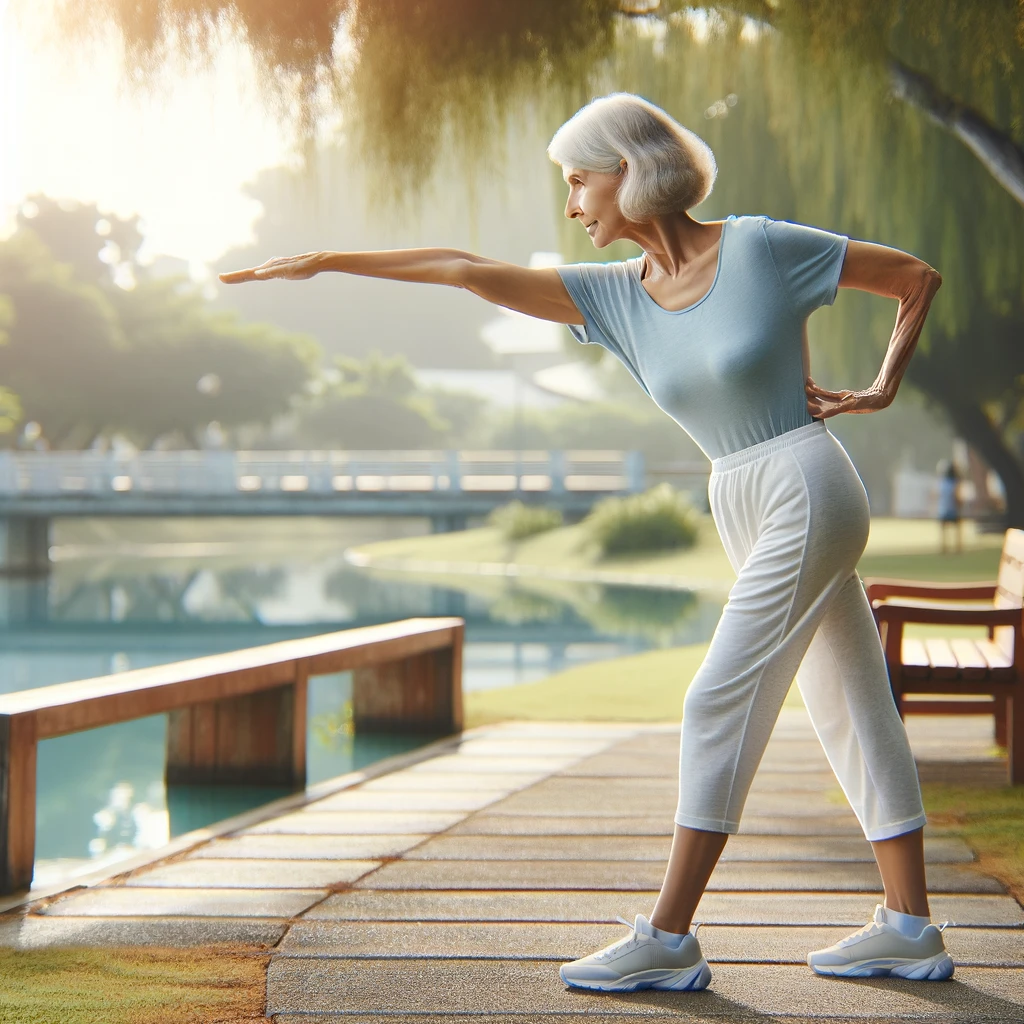
The spine and obliques are stretched during the standing side bend. This facilitates improved posture for daily activities, sports, and new exercises.
For executing a standing side bend:
- Maintain a tall stance by bringing your feet and thighs together. While inhaling, extend both arms straight aloft.
- Attune your right arm to the right-lateral region of your body. Exhale while extending the left arm above the head while gently bending the body to the right.
- After returning both arms overhead with an inhale, repeat on the left side— six to ten repetitions per side.
- If standing causes you to become fatigued or bending requires you to lose equilibrium, perform this exercise in a sturdy chair. If you are comfortable performing chair exercises, try the following ten exercises, which are ideal for seniors.
- Targeted Muscle Groups: Spine and Obliques
5. Wall Push-Ups
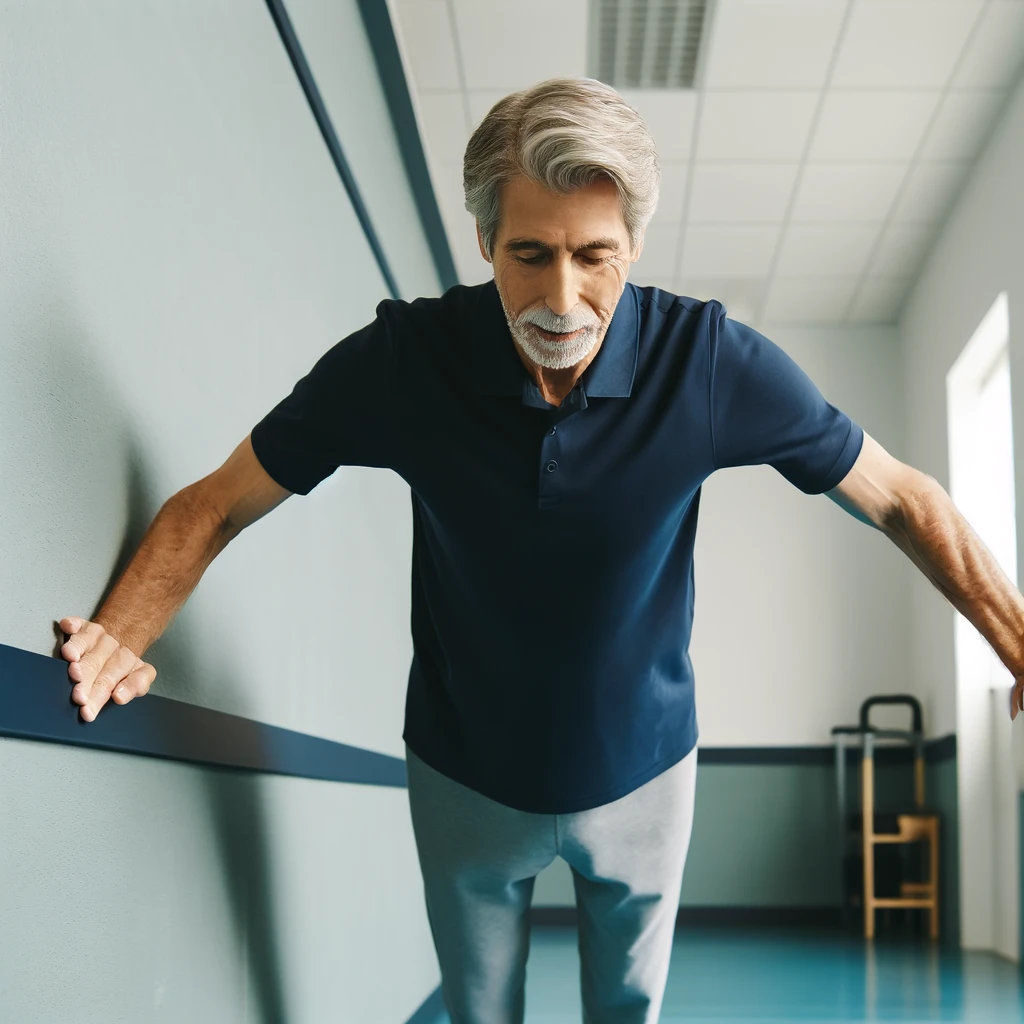
Wall push-ups can benefit seniors as a mobility exercise that strengthens the shoulders, chest, and triceps. They can also assist with activities of daily living, such as lifting oneself from a chair and moving open doors.
To execute a wall push-up:
- Place your palms on a wall shoulder-width apart while standing.
- As you perform a push-up, gradually lower your torso toward the wall. Next, press up again.
- Angle your forearms behind you rather than pointing out to the sides.
- Perform 6–10 reps.
- The following muscle groups are targeted: Gripples and Triceps.
6. Side-To-Side Lunges

This lower body exercise strengthens the inner and outer thighs, quadriceps, buttocks, and hamstrings. Additionally, side-to-side movement enhances equilibrium and stability.
Steps for carrying out a side-to-side lunge:
- Commence standing with toes pointed forward and feet slightly broader than shoulder-width apart.
- While transferring your body weight to one leg, flex your knee at a 90-degree angle. While maintaining a straight limb, contract your glutes behind you.
- Switch sides and return to the center position—six to ten repetitions per side.
- To facilitate this exercise, reduce your range of motion or support your equilibrium by clinging to the back of a chair.
- Targeted muscle groups include the quadriceps, glutes, hamstrings, and outer and inner thighs.
7. Chair Squats

By enhancing lower body strength and hip mobility, this exercise facilitates the development of the necessary prowess to ascend staircases and transition from a seated to a standing position.
To execute a chair squat:
- Position yourself directly in your chair, with your ankles shoulder-width apart and your toes pointing forward while facing away from it.
- While maintaining an elevated chest, flex your legs to squat your hips back and forth. Apply pressure to the chair using your butt.
- Re-establish your push to return to the initial position. Perform 6–10 reps.
- Aiming to strengthen the quadriceps, glutes, and hamstrings
8. Seated Spinal Twists

This exercise stretches the neck, thorax, shoulders, glutes, upper and lower back, and increases spinal mobility.
To execute an upright spinal twist:
- Lean back in a chair and place both feet level on the ground.
- Cross your right foot over your left leg near the pelvis as closely as possible.
- Pull your right knee toward your body while encircling it with your left arm. Slightly twist your torso to the right.
- As you circulate slowly to the opposite side, encircle your ribcage. Proceed for 30 seconds.
- Concentrated On Muscles: Spine and Lower Back
Tips For Doing These Exercises
- Stretching and mobility exercises are designed for seniors with mobility issues who wish to maintain an active lifestyle. They are unsuitable for injured individuals, who ought to be supervised by a physical therapist or another qualified healthcare professional during their recovery process.
- Most of these exercises require a yoga mat and floor space. Additionally, chair exercises involve maintaining a seated position.
- Perform these stretches three to two times per week. Maintain controlled movements and operate at a leisurely tempo. It is even better if you can incorporate them into your daily routine.
- These exercises may initially cause discomfort and stiffness. But with continued practice, your muscles will become warmer, and your joints will become more flexible. Daily physical activity, as well as subsequent exercises, will become more effortless with age.
- Do you need help completing an exercise precisely as written? Joyful tidings! Instructions on how to modify a move are provided.
The Benefits Of Mobility Exercises For Seniors
Before delving into the specific exercises, let us discuss the rationale behind incorporating mobility exercises into your regular exercise regimen.
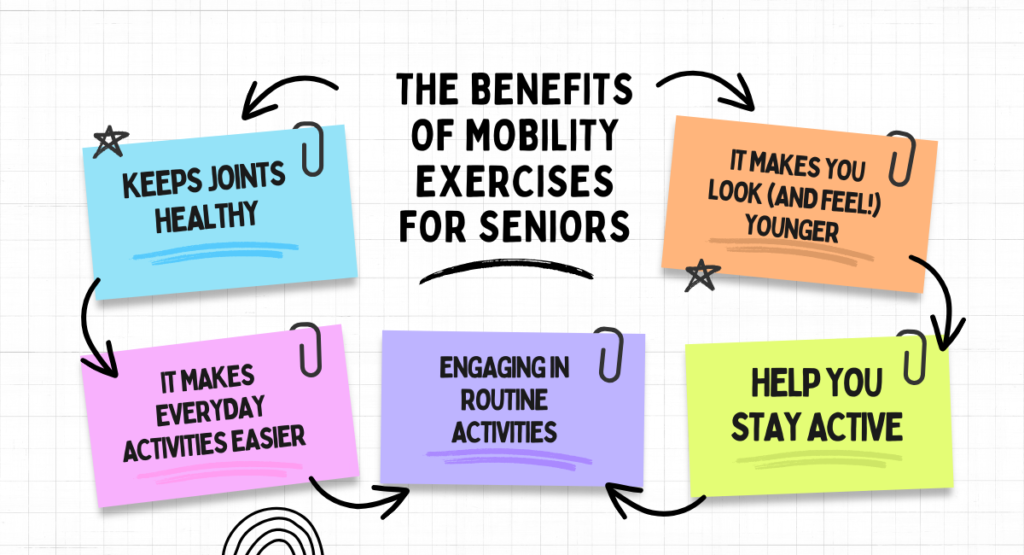
The following are the most notable health benefits of senior mobility exercises:
1. Keeps joints healthy. Movement is a fragrance! Engaging in a healthy range of motion for your joints lubricates them with fluid, maintains their functionality, and may help prevent joint discomfort.
2. It makes everyday activities easier. Joint pain and deterioration are standard as people age, particularly those with arthritis. Movement is frequently the most effective remedy for stiff, aching joints, primarily due to the fluid we discussed previously.
3. Engaging in routine activities. Generally induces improved joint sensations. In addition, teaching your joints to move in a more excellent range of motion enables you to perform a wider variety of movements, as the flexibility and rotation of your shoulders, elbows, wrists, knees, spine, ankles, knees, hips, and spine are no longer constrained. Active living enhances one’s quality of life and is a preventive measure against injury.
4. Help you stay active. In addition to facilitating daily life, mobility exercises can promote physical activity. Physical activity is crucial for preserving muscle strength, heart and respiratory health, mental acuity, and equilibrium. In addition to protecting against chronic diseases, maintaining an active lifestyle can promote independence, mental health, and muscle strength.
5. It makes you look (and feel!) younger. Incapability to move is among the few factors that accelerate aging in appearance and sensation. Mobility exercises are easy to incorporate into your regimen, and consistent use can help you lose years.
Mobility during the senior years is crucial for preserving independence and quality of life. By incorporating consistent mobility exercises into their daily lives, elderly individuals can improve their overall physical health, decrease fall susceptibility, and engage in more vigorous activities.
Consistency and a gradual increase in the intensity of mobility exercises can substantially enhance one’s general health and well-being. Continue to progress and wholeheartedly embrace the path to enhanced mobility and autonomy!



